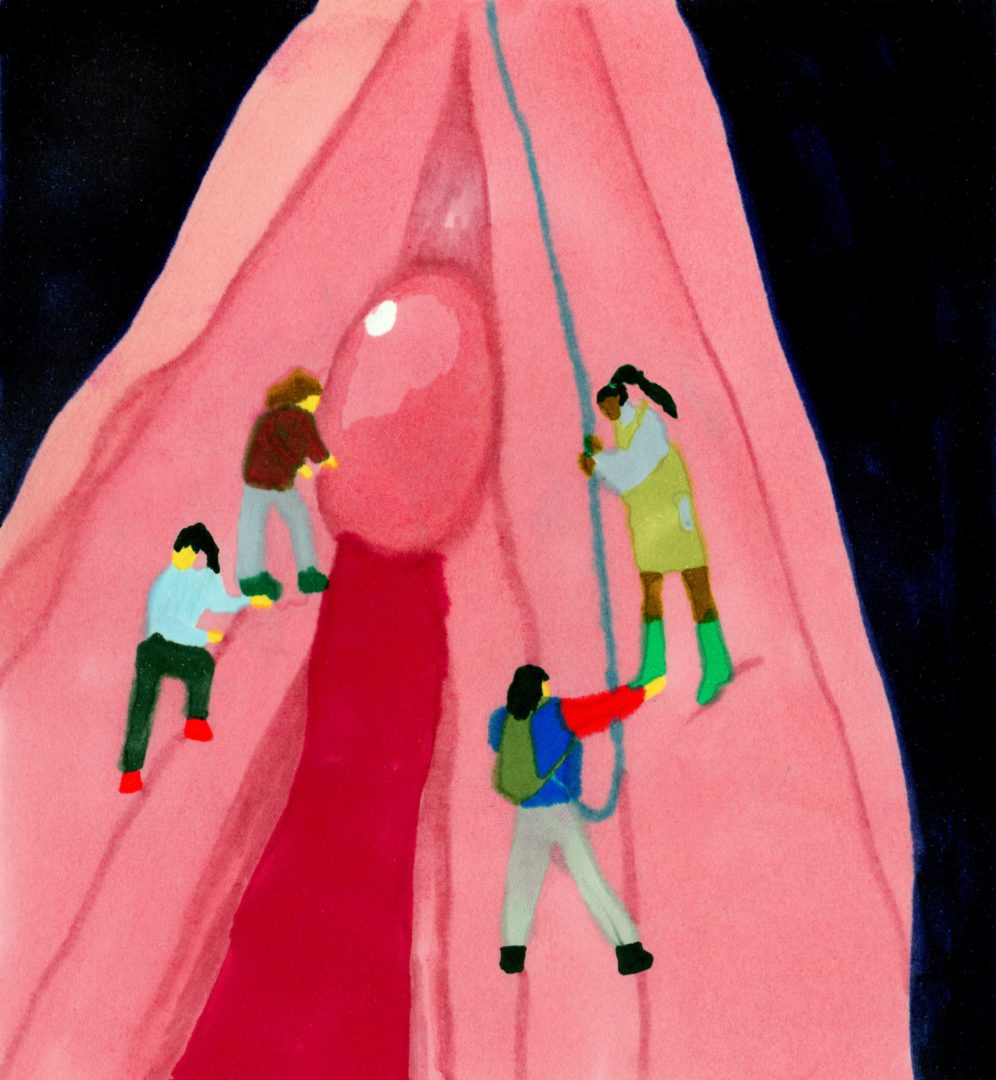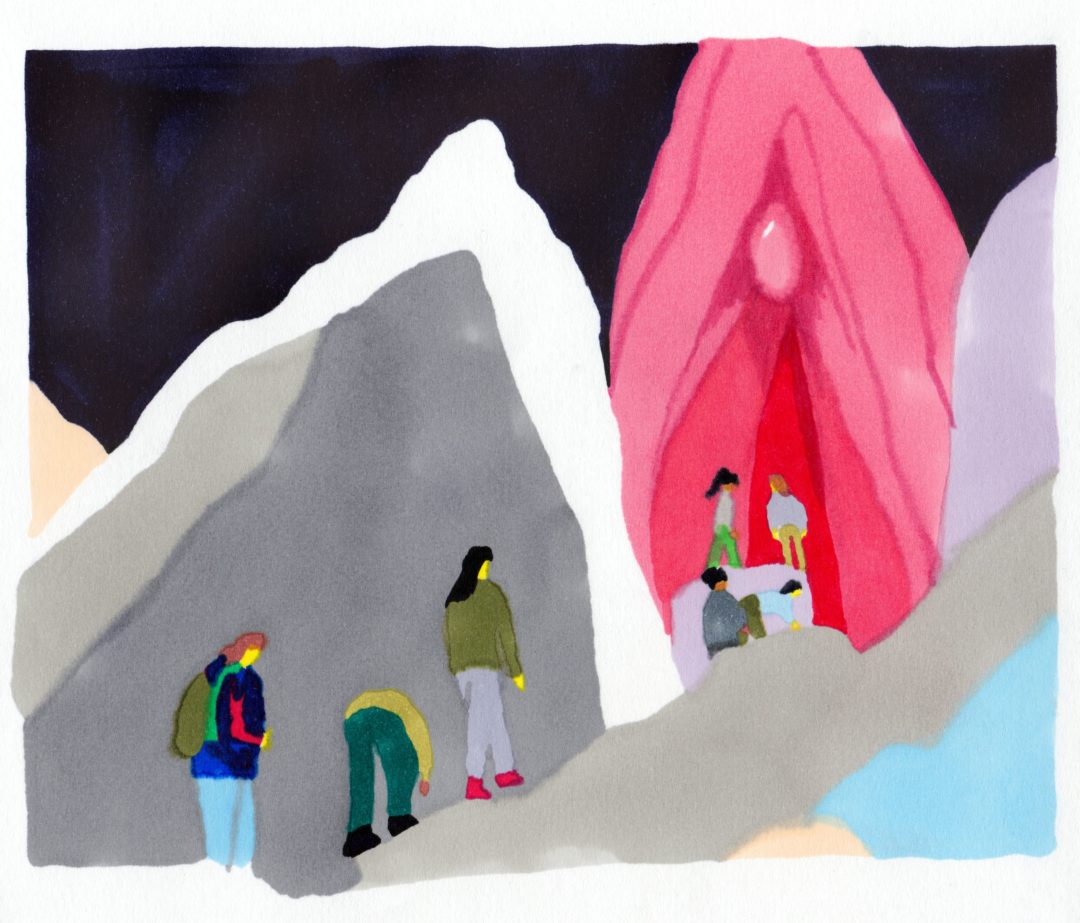Catherine Malabou

Catherine Malabou’s most recent work was published just one year ago by Payot & Rivages. Currently a professor at the University of Kingston, in London, she is a specialist in contemporary French and German philosophy. Her doctoral thesis was a re-reading of Hegelian philosophy seen through the lens of the concept of plasticity, which has become central in her work. Whether applied to the neurosciences, the histories of feminism or anarchism, plasticity has allowed her to construct coherent models; they are equipped with an internal organisation while at the same time remaining flexible enough to allow for reformation in order to adapt. In Pleasure erased. Clitoris and thought, Catherine Malabou establishes a genealogy of medical, psychoanalytical and literary representations of the clitoris. Through her work, she aims to show how the clitoris could be the symbolic incarnation of a specificity belonging not only to all or some women but to the feminine; always in close relation to underrepresented voices—in particular to those which struggle to make themselves heard and eventually find a means to express themselves through a plural and malleable enunciation. It is this aspect that allows her to create linkages between the history of feminism and anarchist thought, a path that leads directly to her forthcoming book, to be published by Presses Universitaires de France in 2022, on anarchism in philosophy.
In Pleasure erased. Clitoris and thought[1], you map an outline of the existing discourse, frugal in nature, relating to the clitoris. Whether we approach the topic from a medical, psychoanalytic or literary standpoint, the clitoris has suffered from a quasi total absence of representation. Due in large part to Freudian theories which describe women as castrated men, this erasure positions them in such a way as to be seen as fundamentally lacking, and defines women institutionally as such. This lack can be elucidated through the perspective of erasure: it denotes a move to negate feminine difference. It then follows that a woman cannot be considered a man who longs to be in possession of a phallus, but is instead a being who has undergone the erasure of a major attribute, an anatomical and symbolic organ which gives pleasure and can reason on its own terms. This double action, the experience of arousal and thought, leads us directly to the title of your essay which connects the two operations: can you explain how the two are related ?
According to Freud, beginning in childhood both girls and boys experience a fear of castration, which comes from the fear of death, of being cut off from something. A girl would then discover that in her case, the castration had already occurred, since she is “cut,” which would then intensify the fear. The clitoris appears as the scar of the penis. The little girl would then experience the absence of a penis as a lack which needed to be compensated for. She would play with this scar and discover that only the vaginal expression of sexuality would lead to the resolution of this shortcoming. This is what enabled Freud to come to the conclusion that clitoral stimulation is a stunted, childlike, masturbatory pleasure, focused on lack and fear. This perspective is what prevents women from experiencing a pleasure which has nothing to do with the lack of having a penis. It is a form of logical excision just as it is a symbolic amputation.
The erasure and invisibilisation of the clitoris can also be found of course in philosophy. For example, Sartre, who I have quoted before, declares that a woman is a being with holes, “waiting to be filled, satisfied,” omitting the fact that women’s sexual organs are made up of more than just holes.

I began wondering as I analysed all of these theories, if the erasure of the clitoris could perhaps lead to an erasure of female pleasure in thought. As if arousal and thought could only conform to a phallic model, what Derrida calls “phallogocentrism,” with its paradigms of erection, ejaculation, penetration, etc. I began thinking about this some time ago in my book A different difference. The feminine in philosophy (Galilée, 2009) by asking myself what type of hybrid being a woman philosopher could possibly be. What could it mean to be a person with the body of a woman and how that could affect their way of approaching philosophical concepts. A question like this had never been properly asked before. My conclusion was that in excluding women, philosophy was depriving itself of a different approach to power dynamics and that basically, the feminine question opened up a space that was absolutely solitary, still unexplored. In Pleasure Erased, I expand upon the concept of female woman, which does not refer to a particular gender but rather a certain way of being exposed, in particular by the very fact of refusing the paradigm of penetration, whether physically or intellectually. A connection exists between the experience of pleasure and thought which stands apart from the phallus and which, far from limiting itself to women, resides in what I call a person’s “clitoral space.”
You introduce the model of the clitoris in contrast to that of the phallus, not only as a biological organ, but also as an epistemological tool. Just as the phallus is a projection of the body part on a symbolic level, you present the figure of the clitoris as another type of arousal to be had through intellection: in contrast to the monumental and unitary moments in thought, erogenous zones emerge as a multiple, collaborative, sometimes contradictory alternative. Given that the notion of the symbolic phallus is familiar to us in psychoanalytical, sociological or anthropological terms, the fact that the idea of approaching the same topic or discussion from the point of view of an exchange between phallic and clitorial moments is much less so is quite troubling. This new perspective leads us to witness a twin discovery: in addition to the existence of clitoral zones in a text, there are also phallic zones. Can you tell us how you characterise each of these two categories? And if the textual clitoris can be defined as the place where logos vacillates, what would a clitoris be located in a work of art?
The phallus, it bears repeating, cannot be assimilated to the penis. As psychoanalysis understands this term introduced by Lacan, the phallus is the unattainable object of desire for men as well as for women. This does not change the fact that the relationship that men and women have with the phallus is different (the woman “is” the phallus, he says, and the man “has” the phallus). However, both see their desire directed by it in the very reflections that their different positions set off. So then what? Lacan was right when he said that sexual relations cannot strictly be about physical satisfaction. The discourse, or the symbolic order, is always involved. Which is a way of saying that there is no desire where there is no fantasy without the symbolic projection of images and words. We tell ourselves the story of the encounter as much as we encounter it. The phallus is precisely the object of projection of the signifier. Which is why Lacan says that there are no sexual relations. There are no purely sexual relations, which are cut off from this symbolic incursion. As long as both sexes are engaged in this projection, albeit in different ways, there is no point in asking whether there might be a specifically feminine sexuality. That is what Lacan responds with contempt to Simone de Beauvoir when he refuses to continue a discussion with her: “there is no second sex.” In other words, clitoral arousal changes nothing fundamental about the phallic nature of desire. Well. And even if he refuses the simple equation phallus/penis, Lacan is still sticking with the phallus! It is difficult to see how it’s different from the male sexual organ ! What a joke.

So then I wondered about whether there might exist, in texts as well as in works of art and bodies, different zones. This is what I called “the point of anarchy.” Clitoral zones would be those that call for a type of non-penetrative interpretation, a kind of caress that would give us a lateral, indirect meaning: the little pleasureful zone that delivers another type of message than the one that gets right to the point and imposes itself. This is the type of reading that I integrated into all of my books, I think. And I think that it’s very possible to pick up on these types of messages in works of art, like all those points that avoid verticality, unity and definition. Which of course does not prevent them from having a form.
As this research project is highly charged with political and epistemological implications, you make your stance clear as of the very first chapter: you aim to align yourself with radical differentialist feminism, while also embracing recent post-binary militant developments. You have managed to create a space for the clitoris through this double affirmation while providing a symbolic and anatomic framework. And yet, this way of thinking is challenging and many militant thinkers struggle with it as it is a bit of a paradox. It seems as though the necessary tools for the reconciliation of these two important feminist traditions come directly from the model of the clitoris that you have developed, especially when you apply its presence and agency to a thousand other contexts aside from the biological. How did you manage to navigate between these two schools of thought, with or without the help of the clitoris?
I don’t know that we can talk about reconciliation, per se, I see it as more of a dialectic between these two movements. However you did accurately highlight the way that my approach aims to think cohesively, aligning these two influential movements, radical feminism and post-feminism, and playing them against one another; the biggest difference being that the former is woman-oriented and the latter concerns being nonbinary.
You are also quite right when you say that this is a challenging topic, indeed it is very divisive one. For example, Silvia Federici recently made several anti-trans statements in the name of radical feminism (something along the lines that a female-to-male trans person is a kind of traitor). There are even some post-feminists who label any effort to advance women’s rights as ‘terf,’ or anti-trans. I would like to state that I do not feel at home in either of these two camps. Thankfully, voices that are not dogmatic in this way do exist. For example, in a Guardian interview, “We need to rethink the category of the woman,” (Sept. 7, 2021), Judith Butler recently said some things that were very on-point: “what it means to be a woman does not remain the same from decade to decade. The category of woman can and does change, and we need it to be that way. Politically, securing greater freedoms for women requires that we rethink the category of “women” to include those new possibilities. The historical meaning of gender can change as its norms are re-enacted, refused or recreated.”
This statement is interesting because it does not pit women against trans, or women against men, or women against non-binary. Without giving up on the category of woman, either, while still emphasising the need to break with outdated notions of gender.
However how could we forget that without feminists who theorise about gender difference such as Irigaray or Lonzi, it would be impossible—just impossible—to understand what the notion of gender entails?
All throughout this discussion about female arousal, you come back to the classic clitoris-vagina dichotomy, informed by recent research showing how these organs collaborate in the process of arousal. In contrast, medical and philosophical traditions build up a male arousal that is solitary, culminates in ejaculation, and most of all involves one single apparatus: the penis, or the unified seat of arousal. Seen from this perspective, it is the unity of the male member that qualifies it as arkhè: principal, authority. By contrast there is the female experience of pleasure, supposedly disseminated and seated in two distinct zones and which lead to its discredit in symbolic and psychoanalytic terms. You bring this classic interpretation up to date by introducing the most recent scientific data regarding the clitoris and the vagina and the way that the two work together. Can we not, by the way, break down this pre-conceived notion of feminine dissemination versus male unity? It is surprising to think that commonly-held ideas of a single male organ involved in arousal as opposed to two female organs have been so rarely called into question. We know that the clitoris, in addition to its external erectile structure also surrounds the internal walls of the vagina; during sexual arousal men have two organs at their disposal: the gland and the prostate. These organs can be described as being even farther removed from one another geographically than the clitoris and the vagina. Given that we are speaking in symbolic terms, this reversal of situations is meaningful. Shouldn’t we not only consider dismantling this model but also the underlying symptom of a patriarchal society built on a system favorising unity and monumentality over composites as well?
Yes, that is right. Masculine arousal is always referred to as one and unitary, as well as its biological sources. And female arousal is attributed to two organs which are the clitoris and the vagina.
This is in large part the reason Carla Lonzi investigates why this anatomic-symbolic situation of female arousal must be systematically set up against the unitary and what you accurately referred to as the monumental. Her text, “The clitoral woman and the vaginal woman” dates from 1974 (and has yet to be translated into French, which is incredible). Lonzi invents the expression “clitoral woman” and associates clitoral arousal with the autonomy of women. She refuses to associate the clitoris with masturbation. For her, the clitoris is the quintessential feminine sexual organ and not the vagina, which is associated with reproduction. According to Carla Lonzi, clitoral arousal is the equivalent of masculine “independent thought.” I think she has a point here, which is that the vision of masculine arousal as a unitary phenomenon leads to independent thought and action. Man as a solitary figure does not let himself be influenced, remaining the master of himself. Lonzi breaks this model of autonomy and links it to the composite model of difference.
If we recognise that the clitoris symbolises female autonomy and difference, accepting female arousal and the clitoris would imply that this autonomy can challenge patriarchy. This vision must then shift the way that men see their own sexuality, as you very justly stated. I hope to have shown in my book that a pluralistic vision of pleasure and bodies is the only one that is worth fighting for.
[1] Catherine Malabou, Editions Payot & Rivages, 2020.
. . .
Head picture : Original illustration of Inès Rousset for 02
- Share: ,
- By the same author: Anna Longo, Patrice Maniglier, Nicolas Bourriaud, Géraldine Gourbe,
Related articles
Céline Poulin
by Andréanne Béguin
Émilie Brout & Maxime Marion
by Ingrid Luquet-Gad
Interview with Warren Neidich
by Yves Citton

